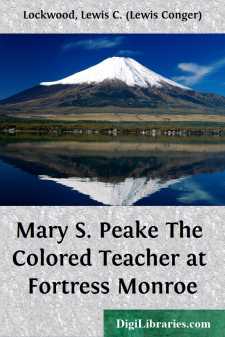Categories
- Antiques & Collectibles 13
- Architecture 36
- Art 48
- Bibles 22
- Biography & Autobiography 813
- Body, Mind & Spirit 142
- Business & Economics 28
- Children's Books 14
- Children's Fiction 11
- Computers 4
- Cooking 94
- Crafts & Hobbies 4
- Drama 346
- Education 46
- Family & Relationships 57
- Fiction 11829
- Games 19
- Gardening 17
- Health & Fitness 34
- History 1377
- House & Home 1
- Humor 147
- Juvenile Fiction 1873
- Juvenile Nonfiction 202
- Language Arts & Disciplines 88
- Law 16
- Literary Collections 686
- Literary Criticism 179
- Mathematics 13
- Medical 41
- Music 40
- Nature 179
- Non-Classifiable 1768
- Performing Arts 7
- Periodicals 1453
- Philosophy 64
- Photography 2
- Poetry 896
- Political Science 203
- Psychology 42
- Reference 154
- Religion 513
- Science 126
- Self-Help 84
- Social Science 81
- Sports & Recreation 34
- Study Aids 3
- Technology & Engineering 59
- Transportation 23
- Travel 463
- True Crime 29
Mary S. Peake The Colored Teacher at Fortress Monroe
Categories:
Description:
Excerpt
CHAPTER I.
Birth and Parentage.—Education.—Religious Convictions.—Prayers in the Tomb.—Union with the Church.—Labors for the Poor.—Marriage.
The subject of this narrative was born in Norfolk, Virginia, in 1823. Her maiden name was Mary Smith Kelsey. Her mother was a free colored woman, very light, and her father a white man—an Englishman of rank and culture. She was a very lovely child in person and manners, and as she grew up, developed traits of character which made her a universal favorite.
When she was six years old, her mother sent her to Alexandria, for the purpose of attending school. She remained there in school about ten years, residing with her aunt, Mary Paine. Mrs. Paine occupied a house belonging to Mr. Rollins Fowle, and near his residence. This gentleman and his family were distinguished for their kindness to colored people. He frequently bought slaves who were in danger of being sold into bad hands, gave them their freedom, and set them up in business. John Paine, Mary's uncle, was one whom he freed in this way. Mary was a great pet in Mr. Fowle's family, and was treated almost like a daughter.
A schoolmate of hers, now residing in Providence, Rhode Island, says Mary was a very amiable girl, and a good student. They for a time attended a select colored school taught by a colored woman. Afterward they attended a colored school taught by white teachers. The last teacher was Mr. Nuthall, an Englishman. He taught till a law of Congress enacted that the law of Virginia in relation to free colored people should prevail in the District of Columbia. This was several years before Alexandria was retroceded to Virginia. This law closed all colored schools in the city. Mary was compelled to leave the school in consequence of being informed of as having come from Virginia.
While at school, Mary acquired a good English education, and, in addition to this, a knowledge of various kinds of needlework, and also dress-making. Her aunt was a devoted Christian, and no doubt had a very happy influence on Mary. Her mother also was converted when Mary was two or three years old. Under these influences she was early the subject of serious impressions. Though fond of general reading and study, there was no book she loved so well as the Bible. This was her companion and text book, and she committed large portions of it to memory.
When sixteen years old, having finished her education, she returned to her mother, at Norfolk. Soon afterward, those religious elements which had existed from early childhood—grown with her growth and strengthened with her strength—became dominant by the grace of God, and asserted their power over her.
Near her residence was a garden, connected with a large old mansion, between Fenchurch and Church Streets. In this garden was a dilapidated family tomb. It was impressed on her mind that she must go into this tomb to pray. At the dead hour of night she sought this gloomy abode of moldering coffins and scattered bones. As she entered and knelt in the death cell, she trembled with a fear which her prayers could not dissipate....


